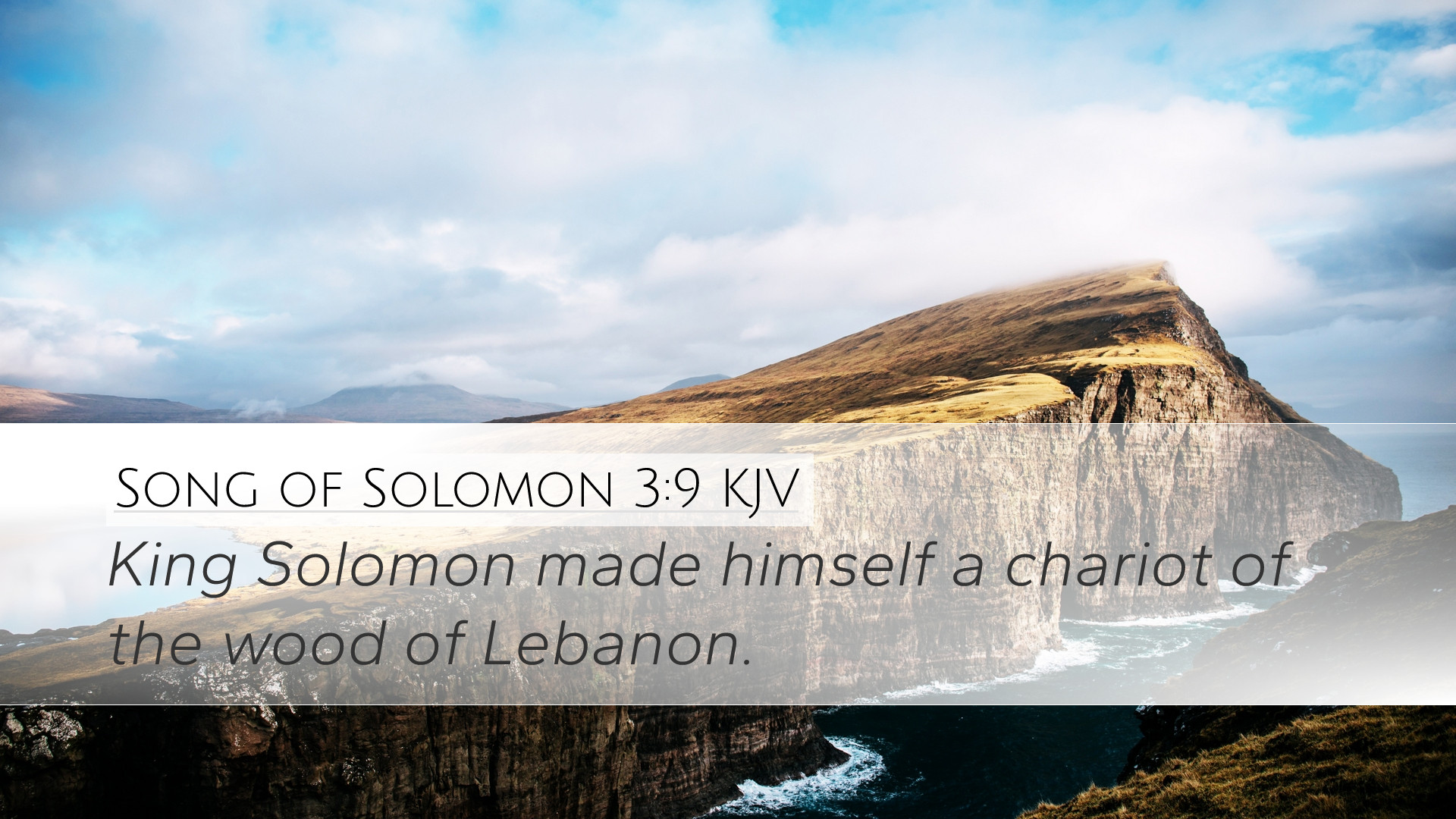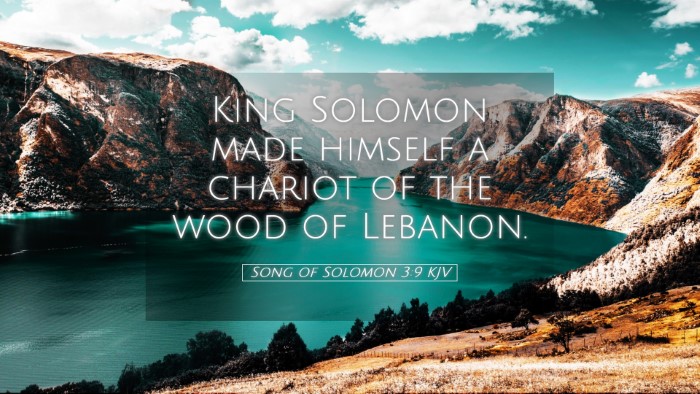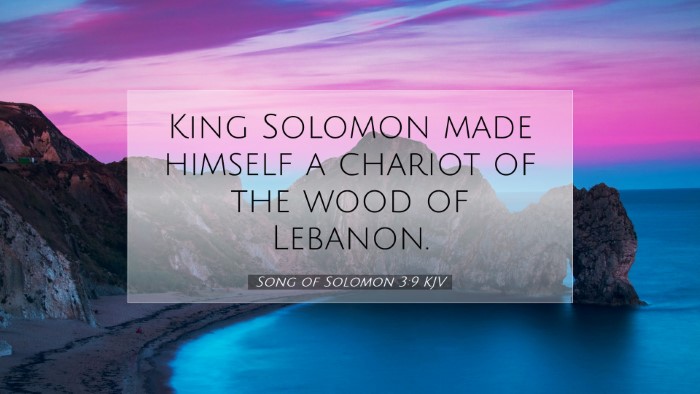Old Testament
Genesis Exodus Leviticus Numbers Deuteronomy Joshua Judges Ruth 1 Samuel 2 Samuel 1 Kings 2 Kings 1 Chronicles 2 Chronicles Ezra Nehemiah Esther Job Psalms Proverbs Ecclesiastes Song of Solomon Isaiah Jeremiah Lamentations Ezekiel Daniel Hosea Joel Amos Obadiah Jonah Micah Nahum Habakkuk Zephaniah Haggai Zechariah MalachiSong of Solomon 3:9
Song of Solomon 3:9 KJV
King Solomon made himself a chariot of the wood of Lebanon.
Song of Solomon 3:9 Bible Commentary
Commentary on Song of Solomon 3:9
Verse: "King Solomon made himself a chariot of the wood of Lebanon." (Song of Solomon 3:9)
Introduction
The Song of Solomon, traditionally attributed to King Solomon, is a profound poetic work that explores themes of love, desire, and the beauty of romantic relationships. In this particular verse, we encounter a metaphorical depiction of a royal chariot, which serves as a symbol of love and the divine wooing of the beloved. This commentary synthesizes insights from various public domain commentaries, providing depth and understanding for pastors, students, theologians, and Bible scholars.
Historical and Literary Context
The Song of Solomon stands out in the Wisdom Literature of the Old Testament. It employs rich imagery and metaphor to express the intensity of love between the beloved and her lover, often interpreted as representing the relationship between God and His people. The mention of Solomon’s chariot reflects both his royal status and the opulence of his reign, highlighting the beauty and grandeur associated with love.
Matthew Henry's Insights
Henry highlights the significance of Solomon's chariot. He writes that this chariot is emblematic of the beauty and grace of the love between the couple involved. The wood from Lebanon, renowned for its quality and durability, is suggestive of the nobility and majesty of Solomon himself. As a king, Solomon's creation of this chariot symbolizes his deep affection and careful intentions towards his beloved.
Albert Barnes' Interpretation
Barnes provides an analysis of the symbolism inherent in the chariot. He explains that the chariot may represent the vehicle of love and the means through which love is expressed and experienced. The grandeur of the chariot built from Lebanese wood speaks to the idea that love is not only profound but also enriched by beauty and care. Barnes makes a point about the necessity for believers to value and nurture love, drawing parallels to spiritual love and the relationship between Christ and the church.
Adam Clarke's Commentary
Clarke offers a detailed examination of the materials used in the construction of the chariot. He notes that the wood of Lebanon was chosen for its strength and aromatic qualities, which can be interpreted as reflecting the strength and sweetness of true love. Clarke emphasizes that the chariot also serves as a vehicle for transporting the beloved, symbolizing the movement and progression of love through various stages of life and relationship.
Theological Reflections
This verse invites us to consider not only the physical aspects of love—represented by the chariot—but also the emotional and spiritual dimensions. The construction of the chariot can be likened to the building of a relationship rooted in mutual care, respect, and commitment. It poses significant questions about how love is demonstrated in our lives and communities.
Symbolism of the Chariot
- Majesty: The chariot of Solomon reflects the majesty associated with divine love, revealing that true love is not merely mundane but elevated and princely.
- Strength: The choice of wood from Lebanon signifies a love that endures, built upon a strong foundation with the finest materials available.
- Transportation: As a means of travel, the chariot symbolizes the journey of love, conveying that love is dynamic, ever-moving, and capable of great adventures.
Practical Applications
For pastors and leaders, this verse can serve as a reminder to celebrate love within the church community. Encouraging congregants to foster loving relationships mirrors the love that God displays toward His own. Students and scholars can delve into the emotional richness of poetry in Scripture, allowing the beauty of language to inspire their understanding of divine and human love.
Key Takeaways:
- The importance of beauty and care in relationships, reflecting God's love for humanity.
- The understanding of love as a journey, full of growth and experiences, requiring ongoing effort and devotion.
- The recognition of the sacredness of romantic love, paralleling the deep commitment and passion found in the relationship between God and His people.
Conclusion
Song of Solomon 3:9 encapsulates the depth of romantic love through the profound imagery of a royal chariot. Through the insights of biblical commentators, we glean a richer appreciation of the multifaceted nature of love. Ultimately, this verse challenges us to reflect on our expressions of love and the materials from which our relationships are built, encouraging all to pursue a love that is both beautiful and enduring.


